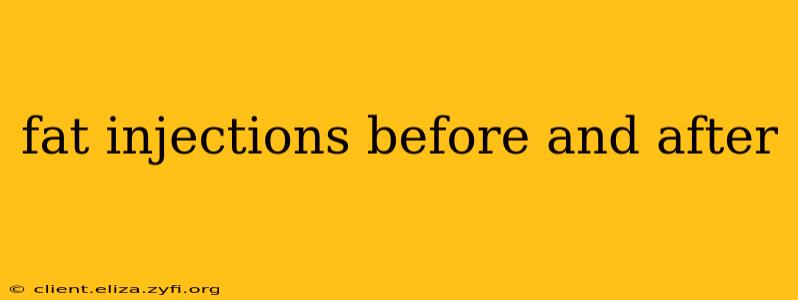Fat injections, also known as autologous fat grafting or fat transfer, are a cosmetic procedure where fat is harvested from one area of the body and injected into another to add volume, enhance contours, or fill wrinkles. This minimally invasive procedure offers a natural-looking alternative to fillers and other cosmetic enhancements. But what can you expect before, during, and after the procedure? Let's delve into the details.
What Happens Before a Fat Injection Procedure?
Before your fat injection procedure, a thorough consultation with a qualified and experienced plastic surgeon or dermatologist is crucial. This consultation will involve:
- Medical History Review: Your doctor will review your medical history, including any allergies, medications you're taking, and previous surgeries. This is vital for assessing your suitability for the procedure and minimizing potential risks.
- Physical Examination: A physical examination will be conducted to assess the areas you wish to treat and evaluate your overall health.
- Imaging (Possibly): In some cases, imaging like ultrasound or CT scans might be used to better visualize the fat deposits and plan the procedure.
- Discussion of Expectations: Realistic expectations are paramount. Your doctor will discuss the potential results, limitations, and possible complications. They'll help you understand what's achievable and what's not.
- Pre-operative Instructions: You'll receive detailed instructions on preparing for your surgery, including dietary restrictions and medication guidelines. This may include avoiding blood-thinning medications for a period before the procedure.
What Happens During a Fat Injection Procedure?
The procedure typically involves these steps:
- Liposuction: Fat is harvested from a donor site (usually areas with excess fat like the abdomen, thighs, or hips) using liposuction. This involves small incisions and a cannula to gently remove the fat.
- Fat Processing: The harvested fat is then processed to separate the fat cells from other tissues. This purification step helps ensure the viability of the transplanted fat cells.
- Injection: Once processed, the purified fat is carefully injected into the targeted areas using fine needles or cannulas. The technique involves strategically placing the fat to achieve the desired aesthetic results.
What are the Potential Risks and Side Effects of Fat Injections?
While generally safe, fat injections carry potential risks and side effects, including:
- Infection: As with any surgical procedure, there's a risk of infection at the injection or harvest sites.
- Bleeding or Bruising: Some bleeding and bruising are common and usually resolve within a few weeks.
- Swelling and Pain: Swelling and pain at the injection and harvest sites are expected and can last for several days or weeks.
- Lumps or Irregularities: In some cases, lumps or irregularities may develop, requiring further treatment.
- Fat Necrosis: In rare cases, fat cells may die, leading to lumps or other complications.
- Unsatisfactory Results: It's important to remember that not all injected fat will survive, and results may not be as dramatic as expected.
What is the Recovery Process Like After Fat Injections?
Recovery varies depending on the extent of the procedure, but generally includes:
- Compression Garments: You'll likely need to wear compression garments for several weeks to minimize swelling and support the treated areas.
- Pain Management: Pain medication may be prescribed to manage any discomfort.
- Follow-up Appointments: Several follow-up appointments will be necessary to monitor your progress and address any concerns.
- Gradual Swelling Reduction: Swelling will gradually decrease over several weeks, and the final results are usually visible after several months.
What is the Lifespan of Fat Injections?
Unlike some fillers, fat injections offer longer-lasting results, as the transplanted fat cells can become incorporated into the recipient site. However, some fat absorption is expected, and the longevity of results can vary depending on factors such as the patient's age, lifestyle, and the treated area.
How Much Do Fat Injections Cost?
The cost of fat injections varies depending on several factors, including the extent of the procedure, the location of the clinic, and the surgeon's fees. It's essential to get a detailed cost breakdown from your chosen provider before proceeding.
How Long Does the Fat Injection Procedure Take?
The duration of a fat injection procedure depends on the extent of the treatment and the number of areas being treated. It can range from a few hours to several hours.
Are Fat Injections Permanent?
While a significant portion of the transferred fat cells can become integrated into the recipient area, some absorption is always possible. Results are not permanent, but they can last for a considerable time – often several years – with many patients finding the effects last longer than with traditional filler injections. Maintenance procedures are sometimes recommended to maintain results.
This information is for educational purposes only and does not constitute medical advice. Always consult with a qualified medical professional before undergoing any cosmetic procedure. Remember to thoroughly research potential providers and ensure they're experienced and qualified to perform fat injection procedures.
